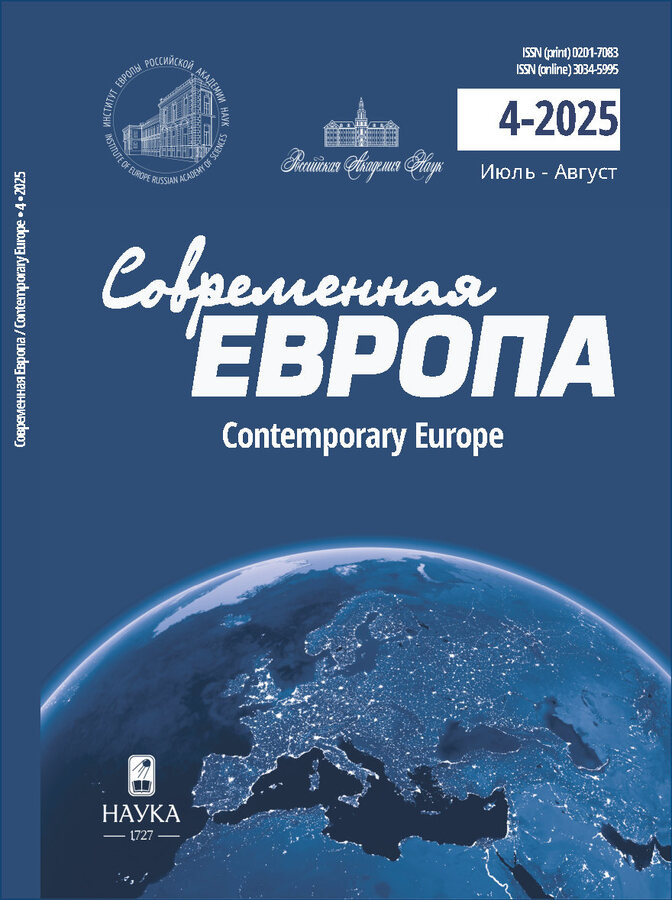Élites and the Church in Italy: Catholic Interpretation of Elitism
- 作者: Yazkova V.E1
-
隶属关系:
- Institute of Europe RAS
- 期: 编号 4 (132) (2025)
- 页面: 190-202
- 栏目: SOCIETY AND RELIGION
- URL: https://rjeid.com/0201-7083/article/view/691015
- DOI: https://doi.org/10.31857/S0201708325040163
- ID: 691015
如何引用文章
详细
The article deals with the arguments used by Italian intellectuals, Catholic hierarchs and theologians to explain their interpretation of the concept of “elite” in general and “elite” in the Church. The aim is to present specific features of the ecclesial interpretation of elite theory in a historical and contemporary perspective. The author highlights the ambiguity of the term. The elite continues to be interpreted both in the structuralist-functional perspective as synonymous with aristocracy, establishment, ruling class, and in axiological key as the best elected part of society that possesses an unquestionable authority among fellow citizens by virtue of intelligence, talent, professionalism, etc. Catholic authors study this phenomenon from an axiological point of view. In this contest, the elitism of political elites has a strong negative connotation. This is explained by the establishments lack of “transparency”. As a result, it loses all personal aspect, becoming a mere political function devoid of any moral component. Criticism of social injustice and other “plagues” of the modern world, begun by the Church, could have cracking features typical of “counter-elite” rhetoric if the Church were a purely political community. But since the Churchs mission is not limited to politics, but determined by the evangelizing mission and Christian witness, Catholic theologians oppose any narrow definition that might reduce the clergy to a kind of elite, counter-elite, political or ideological leaders. The Church contrasts the concept of political elitism with the high moral ideal of religious prophetism and Christian witness.
作者简介
V. Yazkova
Institute of Europe RAS
Email: yazkova@yandex.ru
Candidate of Sciences (History); Master Researcher, Center of religion and society problems, Institute of Europe RAS Moscow, Russia
参考
- Ашин Г.К. (1985) Современные теории элиты: критический очерк. Международные отношения, Москва. 256 с.
- Дмитриева В.Д. (2024) Кардиналы Европы и Африки: сравнительный анализ карьер католической элиты. Власть и элиты. Т. 11. № 4. С. 101–137. DOI: https://doi.org/10.31119/pe.2024.11.4.4
- Дука А.В. (2009) «Элиты» и элита: понятие и социальная реальность. Россия и современный мир. № 1. С. 142–159.
- Карабущенко П.Л. (2013) Рейтинг и антирейтинг элит: имитация и фальсификация элитности в элитах. Каспийский регион: политика, экономика, культура. № 4(37). С. 215–223.
- Тимофеева Л. (2014) Контрэлита современной России: кто она и чего хочет? Россия и мусульманский мир. № 5. С. 14–26. URL: https://lib.rucont.ru/efd/475359 (дата обращения: 04.05.2025).
- Язькова В.Е. (2023) «Мягкая сила» папы Франциска. Мягкая сила» в Черноморско-Средиземноморском регионе [монография]. Доклады Института Европы, № 398, гл. 10. Ин-т Европы РАН, Москва. 194 с.
- Albano E. (2022) La profezia, dono Divino che accompagna la vita della Chiesa. Verso una teologia sinodale. Miscellanea in onore di sua eccellenza mons. Francesco Cacucci. P. 79–101.
- Allard J., Audinet J., Beguerie Ph., Lustiger J.-M. (1971) Table ronde sur la pratique religieuse et pastorale. Élites et Masses dans l’Église. Paris: Desclec de Brouwer. P. 145–166.
- Arlacchi P. (1992) Gli uomini del disonore. La mafia siciliana nella vita del grande pentito Antonio Calderone. Milano: Mondadori. 327 p.
- Bobbio N. (1993) Profilo ideologico del Novecento. Milano: Garzanti.
- Bruni L. (2012) Gli invisibili e tutti noi. Avvenire, 20.08.2012. URL: https://www.avvenire.it/opinioni/pagine/gliinvisibilientitinoi (дата обращения: 30.04.2025).
- Cazelles H. (1971) Élites et masses dans l’Israël biblique. Élites et Masses dans l’Église. Paris: Desclec de Brouwer. P. 35–50.
- Faggioli M. (2016) Populismo o elitismo nella Chiesa. Il Mulino, 30.03.2016. URL: https://www.rivistailmulino.it/a/populismo-o-elitismo-nella-chiesa (дата обращения: 30.04.2025).
- Gauthier N. (1971) Élites et masses dans l’Eglise ancienne. Élites et Masses dans l’Église. Paris: Desclec de Brouwer. P. 51–63.
- Gella A. (1976) An Introduction to the Sociology of the Intelligentsia. The Intelligentsia and the intellectuals: theory, method, and case study. Beverly Hills, CA: SAGE Publications. P. 9–34.
- Montefameglio G. (s.a.) L’estasi e i profeti biblici. Biblistica. URL: https://www.biblistica.it/wp-content/uploads/2016/10/12.-Lestasi-e-i-profeti-biblici.pdf (дата обращения: 11.04.2025).
- Ornaghi L., Parsi V. (1994) La virtù dei migliori. Le élite, la democrazia, l’Italia. Bologna: il Mulino.
- Regoli R. (2009) L’élite cardinalizia dopo la fine dello stato pontificio. Archivum historiae pontifìciae. T. 47. P. 63–87.
- Simon M., Ricciotti G., Tomassoni O. (1935) Profeta e profetismo. Enciclopedia Treccani. URL: https://www.treccani.it/enciclopedia/profeta-e-profetismo_%28Enciclopedia-Italiana%29/ (дата обращения: 21.03.2025).
- Valenza P. (2020) Il Profeta come figura di confine. Polemos. P. 45–67.
- Venard M. (1971). Élites, Masses, Eglise: modèles sociologiques et Peuple de Dieu. Élites et Masses dans l’Église. Paris: Desclee de Brouwer. P. 23–34.
- Veneziani M. (1981) Il maestro disincantato. Pareto V. Borghesia, élites, fascismo. Roma: Giovanni Volpe Editore. P. 5–56.
补充文件









